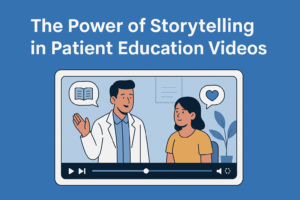The Power of Storytelling in Patient Education Videos
In today’s fast-paced healthcare landscape, effectively communicating complex medical information to patients is more crucial than ever. While traditional methods like brochures and lengthy consultations have their place, a modern approach is transforming patient understanding and engagement: storytelling through patient education videos.
This powerful medium, often seen in the form of healthcare explainer videos and medical animation videos, is not just about presenting facts; it’s about making information relatable, memorable, and actionable.

Why Storytelling Resonates in Healthcare
Humans are hardwired for stories. From ancient fables to modern blockbusters, narratives capture our attention, evoke emotions, and help us process information in a deeper, more meaningful way. In the context of patient education, storytelling offers several invaluable benefits:
-
- Simplifies Complexity: Medical jargon can be overwhelming. A well-crafted story can break down intricate procedures, conditions, or treatment plans into digestible, easy-to-understand segments. By following a character’s journey, patients can see themselves in the narrative, making abstract concepts concrete.
-
- Boosts Retention: Information presented as a story is far more likely to be remembered than a list of bullet points. The emotional connection forged through narrative helps cement key messages in the patient’s mind, leading to better recall and adherence to instructions.
-
- Reduces Anxiety: Facing a medical diagnosis or treatment can be daunting. Stories can demystify the process, offering reassurance by showing how others have navigated similar situations successfully. This empathetic approach can significantly reduce patient anxiety and foster a sense of hope.
-
- Empowers Patients: When patients understand their condition and treatment options clearly, they feel more in control and are better equipped to participate in their own care decisions. Storytelling empowers them by providing knowledge in an accessible format.
-
- Fosters Trust: A transparent and relatable narrative builds trust between healthcare providers and patients. When a video clearly explains what to expect, it demonstrates a commitment to patient well-being and open communication.
The Role of Explainer and Animation Videos
Healthcare explainer videos are adept at concisely communicating a specific concept or process, often using a blend of live-action and graphics. They can walk patients through pre-operative instructions, explain medication side effects, or illustrate the benefits of a new therapy.
Meanwhile, medical animation videos take storytelling to another level, especially for topics that are invisible to the naked eye. Through stunning visuals and dynamic sequences, animation can bring to life the intricate workings of the human body, the mechanism of action of a drug, or the progression of a disease. This visual clarity is unparalleled in helping patients grasp complex biological processes.
Companies like Elephant Productions leverage their expertise in healthcare video production to create informative videos that educate patients and promote practices. They understand how to distill complex medical information into engaging narratives that can be used online, in waiting rooms, or for staff training.
Crafting Impactful Patient Education Stories
Creating effective patient education videos requires more than just technical skill; it demands a deep understanding of the patient’s perspective. Key elements include:
-
- Relatable Characters: Whether animated or live-action, characters that resonate with the target audience make the story more personal.
-
- Clear Problem and Solution: A good narrative identifies a challenge (e.g., a medical symptom) and presents a clear path to resolution (e.g., a treatment).
-
- Emotional Arc: Even in educational content, a subtle emotional journey can make the information more impactful.
-
- Call to Action: Guiding patients on what to do next, whether it’s talking to their doctor, scheduling an appointment, or adopting a new habit.
Conclusion
The integration of storytelling into patient education videos, through the engaging formats of healthcare explainer videos and medical animation videos, is transforming how patients learn and interact with healthcare information. By appealing to human empathy and cognitive processes, these videos do more than inform; they empower, reassure, and ultimately contribute to better health outcomes. For healthcare providers looking to enhance patient understanding and engagement, embracing the power of storytelling is not just an option—it’s an imperative.